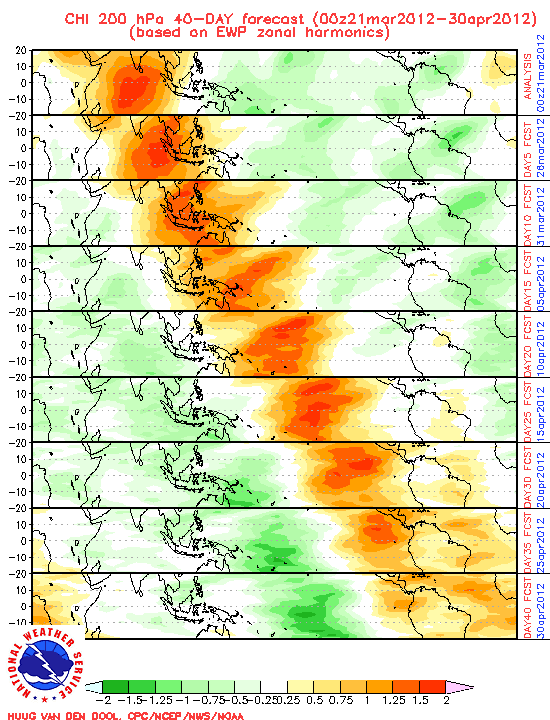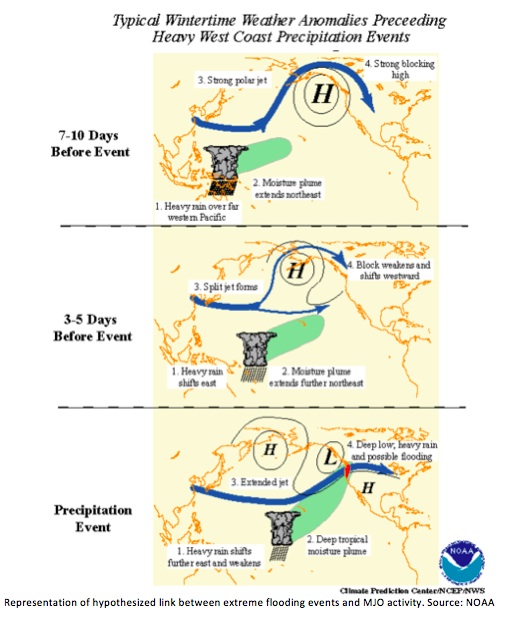Editor's note: Teleconnections are a term used to identify energy links between local and hemispheric weather systems.
TELECONNECTIONS: GLOBAL IMPACTS OF THE MADDEN-JULIAN OSCILLATION
Brigid McKenna
Climate oscillations are the naturally occurring atmospheric wind patterns that drive global weather variation. Their paths are seasonal and dictate intra-annual changes. The prominent ones, North Atlantic and Arctic, are major influences on atmospheric conditions at mid-latitudes. Depending on the origins and pathways they bring warm air to colder regions and vice versa. Arctic air is dragged southwards and surrounded by warmer tropical air with constant heat transference. Rossby waves are the high altitude, fast moving, polar front winds that exist in these oscillations. Jet streams exist within rossby waves and consist of fast narrow bands of air and are responsible for steering and driving Atlantic low pressure systems. For example, when directed to New England during autumn and winter the bands are wet and windy, which is observed in typical daily weather of these seasons.
An oscillation that has been of recent interest in the scientific community is the Madden-Julian (MJO). This highly variable pattern travels eastward along the equator, which is notably different from others that are generally standing and predictable. It is observed over the Indian Ocean and the Pacific Ocean, and brings tropical rainfall as it propagates. It is characterized by varying degrees of convections. Enhanced phases consist of strong winds and high precipitation, while suppressed is the reciprocal. Each cycle lasts about 30-60 days. This intricate process affects the atmospheric conditions by incorporating sea surface temperatures. Ocean currents, up to 100 meters deep, follow in phase with this east-wind influence. Its local effects can be summer monsoons and the enhancement or suppression of tropical cyclones.
Illustration of the Madden-Julian oscillation and its evolution. Source: the University Corporation for Atmospheric Research
Recently there has been speculation that the Madden-Julian oscillation is a strong influence on the North Atlantic oscillation (NAO) and its activities reverberate with global scale effects. The NAO is the standard driving force of weather changes in North America and much of Europe. It has reasonable predictability, but MJO preconditioning can lead changes to storm tracks. A recent study by Lin & Brunet (2009) revealed a two way connection and associated an increase of NAO amplitude after MJO equatorial convection.
Representation of hypothesized link between extreme flooding events and MJO activity. Source: NOAA
There are other non-localized consequences of the Madden-Julian oscillation. There is evidence that although MJO does not cause the oceanic climatic phenomena El Nino and La Nina, it contributes to their speeds, durations, and intensities. There also seems to be a link between an enhanced MJO and extreme flooding in the Pacific Northwest where the MJO does not occupy directly. It influences precipitation and sea surface temperature especially during the winter with an increase of frequency and intensity of heavy precipitation events along the US west coast.
By acknowledging the Madden Julian oscillation as a potential covariate in mid-latitude weather patterns, scientists can more accurately fit climate prediction models and extreme events in both hemispheres.
WORKS CITED
Cassour, C. “Intraseasonal interaction between the Madden-Julian Oscillation and the North Atlantic Oscillation.” Nature 455, 523-527. 28 September 2008. http://www.nature.com/nature/journal/v455/n7212/abs/nature07286.html
Gottschalck, J., & Higgins, W. “Madden Julian Oscillation Impacts.” NOAA/NWS/NCEP Climate Prediction Center. http://www.cpc.ncep.noaa.gov/products/precip/CWlink/MJO/MJO_1page_factsheet.pdf
Lin, Hai, Gilbert Brunet, Jacques Derome, 2009: An Observed Connection between the North Atlantic Oscillation and the Madden–Julian Oscillation. J. Climate, 22, 364–380. http://journals.ametsoc.org/doi/abs/10.1175/2008JCLI2515.1
“Scientists probe Indian Ocean for clues to worldwide weather patterns. 22 September 2011 https://www2.ucar.edu/atmosnews/news/5420/scientists-probe-indian-ocean-clues-worldwide-weather-patterns
Waliser, D. E., K. M. Lau, W. Stern, C. Jones, 2003: Potential Predictability of the Madden–Julian Oscillation. Bull. Amer. Meteor. Soc., 84, 33–50. doi: http://dx.doi.org/10.1175/BAMS-84-1-33

